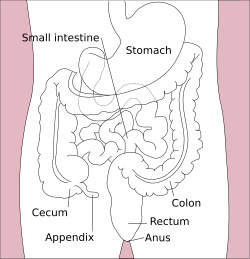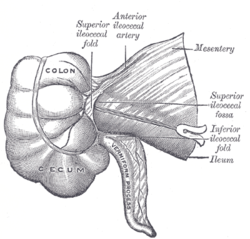Cecum
| Cecum | |
|---|---|
 | |
 Superior ileocecal fossa (cecum labeled at bottom left) | |
| Details | |
| Precursor | Midgut |
| Identifiers | |
| MeSH | D002432 |
| TA98 | A05.7.02.001 |
| TA2 | 2970 |
| FMA | 14541 |
| Anatomical terminology | |
The cecum or caecum (/[invalid input: 'icon']ˈsiːkəm/, plural /ˈsiːkə/; from the Latin caecus meaning blind) is a pouch, connecting the ileum with the ascending colon of the large intestine. It is separated from the ileum by the ileocecal valve (ICV) or Bauhin's valve, and is considered to be the beginning of the large intestine. It is also separated from the colon by the cecocolic junction. The appendix is connected to the cecum. The cecum is usually peritoneal, while the ascending colon is retroperitoneal.[1]
Variation across species
A cecum is present in most amniote species, and also in lungfish, but not in any living species of amphibian. In reptiles, it is usually a single median structure, arising from the dorsal side of the large intestine. Birds typically have two paired ceca, as, unlike other mammals, do hyraxes.[2]
Most mammalian herbivores have a relatively large cecum, hosting a large number of bacteria, which aid in the enzymatic breakdown of plant materials such as cellulose; in many species, it is considerably wider than the colon. In contrast, obligatory carnivores, whose diets contain little or no plant material, have a reduced cecum, which is often partially or wholly replaced by the vermiform appendix.[2] Over 99% of the bacteria in the gut flora are anaerobes,[3][4][5][6][7] but in the cecum, aerobic bacteria reach high densities.[3]
Many fish have a number of small outpocketings, called pyloric ceca, along their intestine; despite the name they are not homologous with the cecum of amniotes, and their purpose is to increase the overall area of the digestive epithelium.[2] Some invertebrates, such as squid,[8] may also have structures with the same name, but these have no relationship with those of vertebrates.
Etymology
The term cecum comes from the Latin caecum, literally "blind", here in the sense "blind gut" or "cul de sac".[citation needed]
In dissections by the Greek philosophers, the connection between the ileum of the small intestines and the cecum was not fully understood. Most of the studies of the digestive tract were done on animals and the results were compared to human structures.[citation needed]
The junction between the small intestine and the colon, called the ileocecal valve, is so small in some animals that it was not considered to be a connection between the small and large intestines. During a dissection, the colon could be traced from the rectum, to the sigmoid colon, through the descending, transverse, and ascending sections. The colon seemed to dead-end into the cecum, or cul-de-sac.[citation needed]
The connection between the end of the small intestine (ileum) and the start of the colon (cecum) is now clearly understood, but the name has not changed.[citation needed]
Development
The cecum and appendix are formed by the enlargement of the postarterial segment of the midgut loop.The proximal part of the bud grows rapidly to form the cecum. The lateral wall of the cecum grows much more rapidly than the medial wall with the result that the point of attachment of the appendix comes to lie on the medial side.[citation needed]
Diseases
A cecal carcinoid tumor is a carcinoid tumor of the cecum. A appendiceal carcinoid tumor (a carcinoid tumor of the appendix) is sometimes found next to a cecal carcinoid.[citation needed]
See also
Additional images
-
Location of McBurney's point (#1)
-
The superior mesenteric artery and its branches
-
Arteries of cecum and vermiform process
-
Inferior ileocecal fossa
-
Interior of the cecum and lower end of ascending colon, showing colic valve
-
Topography of thoracic and abdominal viscera
-
Endoscopic image of cecum with arrow pointing to ileocecal valve in foreground
References
- ^ http://download.videohelp.com/vitualis/med/large_intestine.htm
- ^ a b c Romer, Alfred Sherwood; Parsons, Thomas S. (1977). The Vertebrate Body. Philadelphia, PA: Holt-Saunders International. pp. 353–354. ISBN 0-03-910284-X.
- ^ a b Guarner F, Malagelada JR (2003). "Gut flora in health and disease". Lancet. 361 (9356): 512–9. doi:10.1016/S0140-6736(03)12489-0. PMID 12583961.
{{cite journal}}: Unknown parameter|month=ignored (help) - ^ Sears CL (2005). "A dynamic partnership: celebrating our gut flora". Anaerobe. 11 (5): 247–51. doi:10.1016/j.anaerobe.2005.05.001. PMID 16701579.
{{cite journal}}: Unknown parameter|month=ignored (help) - ^ University of Glasgow. 2005. The normal gut flora. Available through web archive. Accessed May 22, 2008
- ^ Beaugerie L, Petit JC (2004). "Microbial-gut interactions in health and disease. Antibiotic-associated diarrhoea". Best Pract Res Clin Gastroenterol. 18 (2): 337–52. doi:10.1016/j.bpg.2003.10.002. PMID 15123074.
{{cite journal}}: Unknown parameter|month=ignored (help) - ^ Vedantam G, Hecht DW (2003). "Antibiotics and anaerobes of gut origin". Curr. Opin. Microbiol. 6 (5): 457–61. doi:10.1016/j.mib.2003.09.006. PMID 14572537.
{{cite journal}}: Unknown parameter|month=ignored (help) - ^ Williams, L. W. (1910). The anatomy of the common squid : Loligo pealii, Lesueur. American Museum Of Natural History.
{{cite book}}: no-break space character in|first1=at position 3 (help)
External links
- Photo at mgccc.cc.ms.us
- Anatomy figure: 37:03-08 at Human Anatomy Online, SUNY Downstate Medical Center - "Abdominal organs in situ."
- Anatomy figure: 37:06-09 at Human Anatomy Online, SUNY Downstate Medical Center - "The larger intestine."
- Anatomy figure: 39:05-09 at Human Anatomy Online, SUNY Downstate Medical Center - "The cecum with the distal portion of the ileum."
- Anatomy photo:39:14-0101 at the SUNY Downstate Medical Center - "Incisions of the Cecum"
- Cross section image: pelvis/pelvis-e12-2—Plastination Laboratory at the Medical University of Vienna
- Video clip of worms in the Cecum







